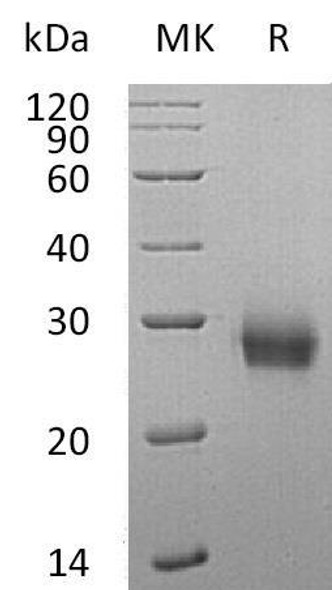Growth Factors & Cytokines Recombinant Proteins
Human RANK Recombinant Protein (RPPB0911)
- SKU:
- RPPB0911
- Product Type:
- Recombinant Protein
- Species:
- Human
- Uniprot:
- Q9Y6Q6
- Research Area:
- Growth Factors & Cytokines
Description
| Product Name: | Human RANK Recombinant Protein |
| Product Code: | RPPB0911 |
| Size: | 10µg |
| Species: | Human |
| Target: | RANK |
| Synonyms: | Tumor Necrosis Factor Receptor Superfamily, Member 11a,NFKB Activator, Loss Of Heterozygosity, 18, Chromosomal Region 1, OsteoclastDifferentiation Factor Receptor, Receptor Activator OfNF-KB, Paget Disease Of Bone 2, ODFR, RANK, Tumor Necrosis Factor ReceptorSuperfamily, Member 11a, Activator Of NFKB, Receptor Activator Of NuclearFactor-Kappa B, CD265 Antigen, LOH18CR1, TRANCER, CD265, OPTB7, OSTS, PDB2, FEO,OFE, Tumor necrosis factor receptor superfamily member 11A. |
| Source: | Sf9 Insect cells |
| Physical Appearance: | Sterile Filtered colorless solution. |
| Formulation: | RANK protein solution (1mg/ml) contains PhosphateBuffered Saline (pH 7.4) and 10% glycerol. |
| Stability: | Store at 4°C if entire vial will be used within 2-4 weeks.�Store, frozen at -20°C for longer periods of time.For long term storage it is recommended to add a carrier protein (0.1% HSA or BSA).Avoid multiple freeze-thaw cycles. |
| Purity: | Greater than 90.0% as determined by SDS-PAGE. |
| Amino Acid Sequence: | ADPLQIAPPCTSEKHYEHLG RCCNKCEPGK YMSSKCTTTS DSVCLPCGPD EYLDSWNEED KCLLHKVCDT GKALVAVVAGNSTTPRRCAC TAGYHWSQDC ECCRRNTECA PGLGAQHPLQ LNKDTVCKPC LAGYFSDAFS STDKCRPWTNCTFLGKRVEH HGTEKSDAVC SSSLPARKPPNEPHVYLPLE PKSCDKTHTC PPCPAPELLG GPSVFLFPPK PKDTLMISRTPEVTCVVVDV SHEDPEVKFN WYVDGVEVHN AKTKPREEQY NSTYRVVSVL TVLHQDWLNG KEYKCKVSNKALPAPIEKTI SKAKGQPREP QVYTLPPSRD ELTKNQVSLT CLVKGFYPSD IAVEWESNGQPENNYKTTPP VLDSDGSFFLYSKLTVDKSR WQQGNVFSCS VMHEALHNHY TQKSLSLSPGKHHHHHH |
RANK, is part of the tumor necrosis factor receptor family. RANK iswidely expressed with uppermost levels in the skeletal muscle, thymus, liver,colon, small intestine, adrenal gland as well as dendritic cells. Furthermore,in activated human peripheral blood T lymphocytes, RANK expression is inducedby IL4 and TGF-b.
RANK produced in Sf9 Baculovirus cells is a single,glycosylated polypeptide chain containing 427 amino acids (28-212a.a.) andhaving a molecular mass of 47.6kDa.�(Molecular size on SDS-PAGE will appear atapproximately 40-57kDa).RANK is expressed with a 242amino acid hIgG-His-tag at C-Terminus and purified by proprietarychromatographic techniques.
| UniProt Protein Function: | TNFRSF11A: Receptor for TNFSF11/RANKL/TRANCE/OPGL; essential for RANKL-mediated osteoclastogenesis. Involved in the regulation of interactions between T-cells and dendritic cells. Binds to the clefts between the subunits of the TNFSF11 ligand trimer to form a heterohexamer. Interacts with TRAF1, TRAF2, TRAF3, TRAF5 and TRAF6. Interacts (via cytoplasmic domain) with GAB2. Ubiquitous expression with high levels in skeletal muscle, thymus, liver, colon, small intestine and adrenal gland. |
| UniProt Protein Details: | Protein type:Membrane protein, integral Chromosomal Location of Human Ortholog: 18q21.33 Cellular Component: external side of plasma membrane; integral to plasma membrane; plasma membrane Molecular Function:cytokine binding; protein binding; receptor activity; transmembrane receptor activity; tumor necrosis factor receptor activity Biological Process: activation of NF-kappaB transcription factor; adaptive immune response; cell-cell signaling; circadian thermoregulation; inflammatory response; osteoclast differentiation; positive regulation of cell proliferation; positive regulation of JNK activity; positive regulation of transcription factor activity; regulation of apoptosis; response to cytokine stimulus; response to lipopolysaccharide; signal transduction; tumor necrosis factor-mediated signaling pathway Disease: Familial Expansile Osteolysis; Osteopetrosis, Autosomal Recessive 7; Paget Disease Of Bone |
| NCBI Summary: | The protein encoded by this gene is a member of the TNF-receptor superfamily. This receptors can interact with various TRAF family proteins, through which this receptor induces the activation of NF-kappa B and MAPK8/JNK. This receptor and its ligand are important regulators of the interaction between T cells and dendritic cells. This receptor is also an essential mediator for osteoclast and lymph node development. Mutations at this locus have been associated with familial expansile osteolysis, autosomal recessive osteopetrosis, and Paget disease of bone. Alternatively spliced transcript variants have been described for this locus. [provided by RefSeq, Aug 2012] |
| UniProt Code: | Q9Y6Q6 |
| NCBI GenInfo Identifier: | 19924309 |
| NCBI Gene ID: | 8792 |
| NCBI Accession: | Q9Y6Q6.1 |
| UniProt Secondary Accession: | Q9Y6Q6,Q59EP9, I4EC36, I4EC38, I4EC39, I7JE63, N0GVH0 |
| UniProt Related Accession: | Q9Y6Q6 |
| Molecular Weight: | |
| NCBI Full Name: | Tumor necrosis factor receptor superfamily member 11A |
| NCBI Synonym Full Names: | TNF receptor superfamily member 11a |
| NCBI Official Symbol: | TNFRSF11A�� |
| NCBI Official Synonym Symbols: | FEO; OFE; ODFR; OSTS; PDB2; RANK; CD265; OPTB7; TRANCER; LOH18CR1�� |
| NCBI Protein Information: | tumor necrosis factor receptor superfamily member 11A |
| UniProt Protein Name: | Tumor necrosis factor receptor superfamily member 11A |
| UniProt Synonym Protein Names: | Osteoclast differentiation factor receptor; ODFR; Receptor activator of NF-KB; CD_antigen: CD265 |
| UniProt Gene Name: | TNFRSF11A�� |






